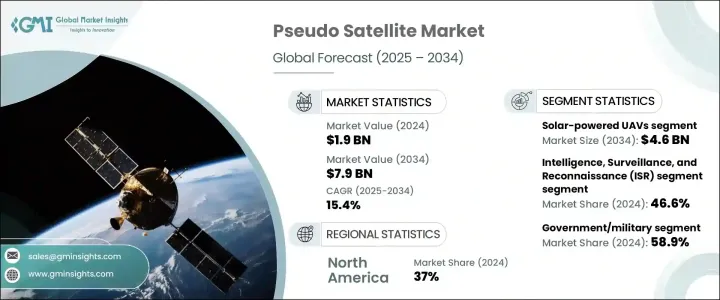
세계의 의사 위성 시장은 2024년 19억 달러로 평가되었고, 2034년까지 CAGR 15.4%로 성장해 79억 달러에 이를 것으로 추정되고 있습니다.
이러한 고도의 플랫폼은 비용 효율성, 유연성, 전통적인 위성 및 항공기와 같은 물류 문제없이 장기간 공중에 머물 수있는 능력으로 인기를 얻고 있습니다. 이 플랫폼은 현재 광역 감시, 환경 데이터 수집, 재해 대응, 서비스가 미치지 못하는 지역에서의 통신 커버를 위해 개발되고 있습니다.

최근 관세 정책은 항공우주 생태계 전체에 현저한 파급 효과를 가져다 주며, 특히 중요한 위성 부품의 가격과 이용 가능성에 영향을 미쳤습니다. 무역 제한에 직면하고 있는 국가에서는 조달 장벽이 높아지고 있어 중립 시장의 국제 제조업체가 견인력을 얻는 길이 열리고 있습니다.
| 시장 범위 | |
|---|---|
| 시작 연도 | 2024년 |
| 예측 연도 | 2025-2034년 |
| 시작 금액 | 19억 달러 |
| 예측 금액 | 79억 달러 |
| CAGR | 15.4% |
태양전지 구동 UAV는 친환경 운영과 구름 위를 비행하는 능력으로 고도의 시인성과 저탄소 실적를 필요로 하는 미션에 이상적이기 때문에 2034년까지 그 가치는 46억 달러에 달할 것입니다. 강화된 태양에너지 시스템과 첨단 배터리 기술의 조합은 이러한 플랫폼의 효율성과 내구성을 향상시키고, 특히 모니터링, 긴급 대응 및 통신 용도에 적합합니다.
2024년에는 첩보, 감시 및 정찰(ISR) 분야가 시장 전체의 46.6%의 점유율을 차지합니다. 성층권에서의 지속적인 운용 능력에 의해 기존 항공기나 위성이 직면하는 제약을 받지 않고, 원활한 데이터 수집이 가능하게 됩니다.
미국 의사 위성 고고도 플랫폼 시스템(HAPS) 시장은 2034년까지 24억 달러에 이를 것으로 예측됩니다. 제한된 지역에서 정보, 감시 및 정찰(ISR) 능력을 확대하고 있습니다.
BAE Systems plc, AEROSTAR, AURORA FLIGHT SCIENCES, Airbus, Thales와 같은 주요 기업은 의사 위성 시장에서 우위를 차지하기 위해 혁신 주도 전략을 채택하고 있습니다. AEROSTAR와 Aurora Flight Sciences는 가볍고 확장 가능한 솔루션을 제공하기 위해 설계 및 엔지니어링에 대한 투자를 강화합니다. BAE Systems는 방위 응용 분야에서 HAPS 채택을 가속화하기 위해 정부 기관과의 파트너십을 확대하고 있으며, 각 회사는 전략적 제휴를 맺고 자율 기술에 투자하거나 미개척 시장을 목표로 하여 세계적인 발자취를 강화하고 진화하는 운영 요건을 도입하려고 합니다.
The Global Pseudo Satellite Market was valued at USD 1.9 billion in 2024 and is estimated to grow at a CAGR of 15.4% to reach USD 7.9 billion by 2034, largely driven by the rising demand for long-endurance aerial platforms that can offer continuous monitoring and surveillance capabilities across a range of sectors. These high-altitude platforms are gaining popularity due to their cost-efficiency, flexibility, and ability to remain airborne for extended durations without the logistical challenges of traditional satellites or aircraft. Growing concerns over national security, border surveillance, and emergency communications are accelerating the adoption of pseudo satellites globally. These platforms are now being developed for wide-area monitoring, environmental data collection, disaster response, and telecommunication coverage in underserved regions.

Tariff policies in recent years have created notable ripple effects across the aerospace ecosystem, particularly impacting the pricing and availability of vital pseudo satellite components. Increased costs of structural and electronic parts have led to delays in stratospheric deployment timelines, placing a strain on supply chains. Countries facing trade limitations are experiencing higher procurement barriers, which opens the door for international manufacturers in neutral markets to gain traction. Shifting global dynamics have encouraged the emergence of alternative suppliers and driven a competitive realignment across regions.
| Market Scope | |
|---|---|
| Start Year | 2024 |
| Forecast Year | 2025-2034 |
| Start Value | $1.9 Billion |
| Forecast Value | $7.9 Billion |
| CAGR | 15.4% |
Solar-powered UAVs are expected to reach USD 4.6 billion in value by 2034 due to their environmentally friendly operations and ability to fly above cloud cover, making them ideal for missions that require high-altitude visibility and a low carbon footprint. Enhanced solar energy systems, combined with advanced battery technologies, have increased the efficiency and endurance of these platforms, especially for surveillance, emergency response, and communication applications.
In 2024, the Intelligence, Surveillance, and Reconnaissance (ISR) segment held a 46.6% share of the overall market. These platforms offer exceptional situational awareness for military and security purposes, supporting mission-critical operations like border control, oceanic monitoring, and troop movement observation. Their persistent operational ability in the stratosphere allows for seamless data collection without the limitations faced by conventional aircraft or satellites.
U.S. Pseudo Satellite Market is expected to reach USD 2.4 billion by 2034, driven by robust governmental support and rising public-sector investments in high-altitude platform systems (HAPS). Federal agencies leverage these platforms to expand intelligence, surveillance, and reconnaissance (ISR) capabilities, particularly in areas with limited access to conventional infrastructure. With growing emphasis on homeland security and situational awareness, pseudo satellites are being integrated into national defense strategies to enable continuous monitoring of borders, maritime zones, and sensitive installations.
Key players such as BAE Systems plc, AEROSTAR, AURORA FLIGHT SCIENCES, Airbus, and Thales are adopting innovation-driven strategies to stay ahead in the pseudo satellite market. Airbus focuses on solar endurance platforms to meet rising ISR and telecom needs, while Thales is advancing software-defined communication payloads for high-altitude systems. AEROSTAR and Aurora Flight Sciences are ramping up their design and engineering investments to deliver lightweight and scalable solutions. BAE Systems is expanding its partnerships with government agencies to accelerate HAPS adoption in defense applications. Companies are also entering strategic alliances, investing in autonomous technologies, and targeting untapped markets to reinforce their global footprint and capture evolving operational requirements.